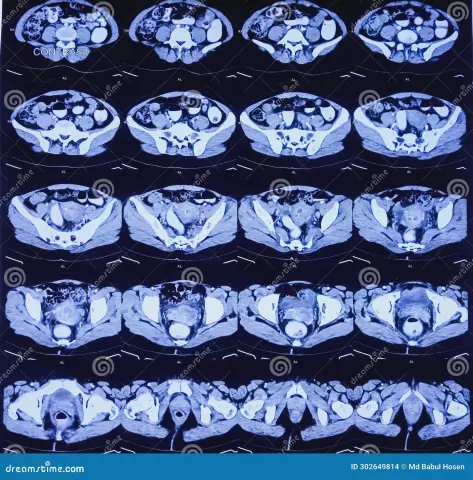- Author Rachel Wainwright [email protected].
- Public 2023-12-15 07:39.
- Last modified 2025-11-02 20:14.
Oncocytology

Oncocytology or Pap smear is a method of microscopic examination of cells taken from the surface of the cervix and cervical canal to detect cancerous changes.
A smear for oncocytology is indicated for regular passage to all women, especially patients at risk, allowing to identify pathological areas on the cervix, clarify the diagnosis and adjust the tactics of further examination and treatment. An annual diagnostic examination of the cervix for oncocytology is recommended:
- Women whose families have had cases of cancer;
- Patients with high titers of human papillomavirus;
- Patients with cervical erosion.
Oncocytology of the cervix: technique
Oncocytology of the cervix is a part of the usual gynecological examination, it is carried out quickly, practically painless and does not require the purchase of expensive equipment and medicines. During the study, the doctor receives a biomaterial (a certain number of cells from the surface of the cervix) using a special cervical brush with soft bristles.
Immediately after taking the biomaterial, the specialist prepares a smear-imprint: for this, the doctor touches the entire surface of the slide with a cytobrush. The number of glasses (preparations) can vary from one to three. Next, the prepared smear for oncocytology is dried in air, placed in a cuvette (narrow glass dish) and fixed with 96% ethyl alcohol for 5 minutes. The next stage of the test is the study of the biomaterial in the laboratory by cytologists.
Storage of glasses with fixed smears is allowed at a temperature of 3-8 degrees Celsius for 10 days and only in sealed packaging.
Preparation for oncocytology
Oncocytology of the cervix does not guarantee an accurate result if the examination was carried out against the background of an inflammatory process in a woman's genitals. An experienced doctor will recommend a Pap smear after anti-inflammatory treatment. It is also not recommended to conduct oncocytology during menstrual bleeding.
For 48 hours before the study, patients need to refrain from sexual activity, the use of vaginal tampons, creams, suppositories, douching, and medications. Before the oncocytology test, it is more advisable to carry out personal hygiene with the help of a vertical shower, giving up the bath for 1-2 days. A smear for oncocytology is taken before a gynecological examination or colposcopy, or 48 hours after these procedures.
Interpretation of results in oncocytology

Pap smears can be positive or negative. Normally (with negative results of oncocytology), the cells of the taken biomaterial are of normal size and shape. A positive smear is detected when cells with abnormalities are detected.
A positive smear for oncocytology does not always mean that a woman has cancer. Common causes of abnormalities in the Papanicolaou test are infections such as chlamydia, gonococcus, Trichomonas, as well as candidiasis and human papillomavirus, which can cause genital warts in the female internal and external genital organs. The condyloma virus can cause benign changes in the cervix. Human papillomavirus of high oncogenic risk can cause the development of cancer, which is characterized by the most altered abnormal cells found on the results of oncocytology.
Pap smear cytological classification:
- 1st grade. Normal cytology;
- 2nd grade. There is a change in cell morphology caused by the inflammatory process in the female genital organs;
- 3rd grade. Single cells with abnormalities of the cytoplasm and nuclei were revealed;
- 4th grade. Individual cells with pronounced signs of malignancy;
- 5th grade. A large number of cancer cells. The presence of a malignant neoplasm is beyond doubt.
The treatment plan depends on the degree of cellular changes detected by the cytologist. If cell abnormalities are associated with an inflammatory process, appropriate treatment is prescribed, and the smear for oncocytology is repeated after a few months. Low and high abnormalities are always indications for colposcopy - a more accurate examination of the cervix, vagina and vulva using an instrument similar to a microscope. In case of detection of pronounced cellular changes, the specialist can take a sample for a biopsy, and further medical recommendations will depend on the results of the histological report.
Found a mistake in the text? Select it and press Ctrl + Enter.






